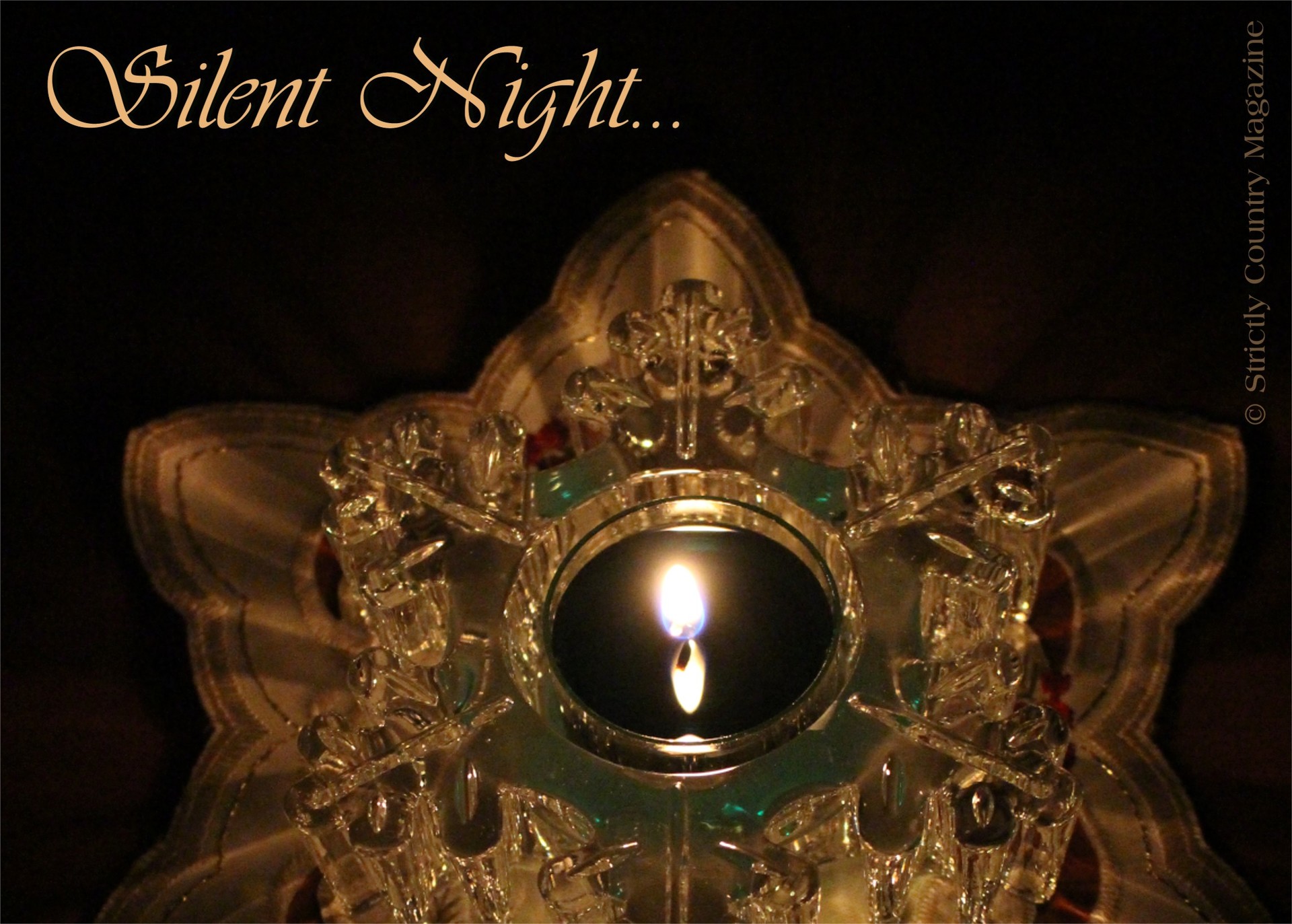
Please shop now!
WE ARE IN THE FINAL DAYS OF CLOSING THIS SITE FOR GOOD!!!
Please make your selection and purchases NOW!
This site is slated permanently shut down any day!

In 2018, Salzburg and the world
celebrate the bicentennial of
a song of peace.
By: Gina Kay Singerhouse
Editor
On a cold winter’s night in the Austrian Alps, a man of the cloth sits in his bleak room. Lit only by candle, the room is cold from the winter wind that blows outside. The man’s heart is heavy as he reflects upon the conditions of the people within his town of Oberndorf bei Salzburg. He is a simple man of the cloth and the burden he bares is heavy with despair.
The town is laden with friends and neighbors deprived of food, shelter and the essential needs to keep a soul alive. The town itself lost its independence that year. More so, a massive fire began in the kitchen of the building complex of the Holy Trinity church that ravaged much of the town, leaving residents homeless.
The young priest, Joseph Mohr, walked outside to take a look upon the town that he so loved. He then retreated to the chapel to pray…
“Lord, why hast thou forsaken my neighbors? What can I do to help them?”
After much reflection, Joseph lifted his head and it is then that his eyes fell upon a painting of Jesus and the nativity. The golden curls graced the baby Jesus is what inspired Joseph to write a poem a couple of years earlier...
Stille Nacht! Heilige Nacht!
Alles schläft; einsam wacht
Nur das traute heilige Paar.
Holder Knab im lockigten Haar,
Schlafe in himmlischer Ruh!
Schlafe in himmlischer Ruh!
Stille Nacht! Heilige Nacht!
Gottes Sohn! O wie lacht
Lieb´ aus deinem göttlichen Mund,
Da uns schlägt die rettende Stund`.
Jesus in deiner Geburt!
Jesus in deiner Geburt!
Stille Nacht! Heilige Nacht!
Die der Welt Heil gebracht,
Aus des Himmels goldenen Höhn
Uns der Gnaden Fülle läßt seh´n
Jesum in Menschengestalt,
Jesum in Menschengestalt
Stille Nacht! Heilige Nacht!
Wo sich heut alle Macht
Väterlicher Liebe ergoß
Und als Bruder huldvoll umschloß
Jesus die Völker der Welt,
Jesus die Völker der Welt.
Stille Nacht! Heilige Nacht!
Lange schon uns bedacht,
Als der Herr vom Grimme befreit,
In der Väter urgrauer Zeit
Aller Welt Schonung verhieß,
Aller Welt Schonung verhieß.
Stille Nacht! Heilige Nacht!
Hirten erst kundgemacht
Durch der Engel Alleluja,
Tönt es laut bei Ferne und Nah:
Jesus der Retter ist da!
Jesus der Retter ist da!
The first is the original German text and below is a direct translation into English. The intent here is not to make translated lyrics, which fit the melody, but rather to provide you with a better understanding of the original German text.
Silent night! Holy night!
All are sleeping, alone and awake
Only the intimate holy pair,
Lovely boy with curly hair,
Sleep in heavenly peace!
Sleep in heavenly peace!
Silent night! Holy night!
Son of God, O how he laughs
Love from your divine mouth,
Then it hits us - the hour of salvation.
Jesus at your birth!
Jesus at your birth!
Silent night! Holy night!
Which brought salvation to the world,
From Heaven's golden heights,
Mercy's abundance was made visible to us:
Jesus in human form,
Jesus in human form
Silent night! Holy night!
Where on this day all power
of fatherly love poured forth
And like a brother lovingly embraced
Jesus the peoples of the world,
Jesus the peoples of the world.
Silent night! Holy night!
Already long ago planned for us,
When the Lord frees from wrath
Since the beginning of ancient times
A salvation promised for the whole world.
A salvation promised for the whole world.
Silent night! Holy night!
To shepherds it was first made known
By the angel, Alleluia;
Sounding forth loudly far and near:
Jesus the Savior is here!
Jesus the Savior is here!
Joseph was a student of music and through he studies; he met a schoolmaster and musician named Franz Xaver Gruber. While preparing for the Christmas Eve Mass, Mohr desired to bring peace to his people who attended his service. Joseph shared his poem with Franz and asked if he could write a simple melody for the Christmas Eve service. In a short while, Gruber had created a modest melody with his guitar.
It is unclear if the stories about the organ are true or if they were part of the devised plan of Joseph Mohr to create a simple and honest service. Nonetheless, it is said that the chapel’s organ was damaged by mice and could not be played on the holiest of nights. This may have been the reason Mohr sought Gruber to write the melody.
On Christmas Eve, 1818, in St. Nicholas parish church in Oberndorf—Joseph Mohr and Franz Xaver Gruber gave the very first public performance of the song that Mohr called “Christmas Carol” a song that the world has come to know as “Silent Night.”
According to Gruber, an organ builder who serviced the instrument at the Oberndorf church, named Karl Mauracher, was enamored with the song. Karl took the composition back home to Zillertal. It is there that the song was captured by two traveling families of folk singers, the Strassers and the Rainers. Both included the song in their shows.
The Rainers were the first to bring the song to the United States. “Stille Nacht” was first performed in New York City in 1839. The melody that we know today was changed during this time.
As with many great songs, the author’s name was forgotten. Although Gruber was known to be the composer, many believed that the melody was composted by a more known person such as Mozart or Beethoven. Nonetheless, in 1995 a manuscript that was dated circa 1820 was discovered. This manuscript is the only one in Mohr’s handwriting and is known as the earliest one to exist today.
It was another priest, John Freeman Young, who was serving at Trinity Church in New York City, wrote and published the English translation in 1859. Young translated three of Mohr’s original six verses to the version in which we know today.
Silent night, holy night,
All is calm, all is bright
Round yon virgin mother and child.
Holy infant, so tender and mild,
Sleep in heavenly peace,
Sleep in heavenly peace.
Silent night, holy night,
Shepherds quake at the sight;
Glories stream from heaven afar,
Heavenly hosts sing Alleluia!
Christ the Savior is born,
Christ the Savior is born!
Silent night, holy night,
Son of God, love's pure light;
Radiant beams from thy holy face
With the dawn of redeeming grace,
Jesus, Lord, at thy birth,
Jesus, Lord, at thy birth.
Gruber’s original melody was more of a moderato tune performed in a 6/8 time. Today’s version of the melody is slow, and in a meditative lullaby. Today, the lyrics are public domain and have been translated into approximately 140 different languages.
The song has been recorded by a very large number of entertainers from every music genre. On February 21, 1935, Bing Crosby recorded his version of the classic carol thus bringing it to the global stage. Bing’s recording is the third best-selling single of all-time.
The history of the song does not end with the English translation. In fact, the song played a major part in a miracle that took place during World War I.
In December 1914, World War I had bogged down in intractable trench warfare with no end in sight. It was Christmas Eve and it was jarringly quiet on the Western Front. A British sentry noticed a glistening light on the German side, less than 100 yards away. The British soon realized that the German line was littered with a whole string of small conifers that glimmered like beads on a necklace.
From the German trenches a faint sound rose. It was a sound never before heard on the battlefield—a Christmas carol. Across the frontline, they heard the German words to “Stille Nacht.” Although the British did not understand the words, they did recognize the melody. When the German soldiers finished singing, their foes broke out in cheers. Instead of returning fire, the British replied in song with the English version of “Silent Night.”
The miracle came at first light. Throughout the five-hundred mile Western Front, sporadic pockets of unarmed German and Allied soldiers tentatively emerged from their trenches and cautiously crossed the killing fields to wish each other a Merry Christmas.
Unbeknown to most, Pope Benedict XV had called for a cease fighting around Christmas. Nonetheless, political leaders ignored the call. However, soldiers in the trenches decided to stage their own unofficial, spontaneous cease-fire.
During this Christmas miracle, soldiers from both sides gathered and exchanged stories, gifts and even buried their dead. Gifts of buttons, cigarettes, chocolates, sausages, liquor and plum puddings were exchanged by the soldiers. In some cases, a make shift game of soccer broke out among the soldiers.
As sun set on Christmas, the soldiers bid each other farewell and returned to their respective trenches. A few of the ceasefires held on until New Year’s Day. Nonetheless, many resumed on December 26.
The following Christmas would not see another miracle like it did the previous year. In fact, the guns of World War I did not fall silent until the signing of the armistice on November 11, 1918, nearly one hundred years after Joseph Mohr and Franz Xaver Gruber first performed “Stille Nacht.”
Today, “Silent Night” is celebrated and sung by billions of people every year. The song is at the heart of the Christmas songbook for every major entertainer. It is a song that permeates all of our lives throughout every generation.
Through the years we have heard entertainers like Dolly Parton, Reba McEntire, Aaron Tippin, Alan Jackson, Andy Griffith, Andy Williams, Anne Murray, Brad Paisley, Charlie Daniels, Elvis Presley, Faith Hill, Frank Sinatra, Guy Penrod, Jim Reeves, John Denver, Johnny Cash, Kenny Rogers, Loretta Lynn, Martina McBride, Michael W. Smith, Restless Heart, Sidewalk Prophets, The Judds, The Nitty Gritty Dirt Band, Larry Gatlin and The Gatlin Brothers, Trinity River Band, and Willie Nelson record their renditions of this classic carol. Steve Wariner included an instrumental version on his Christmas album.
For many years, we felt that the best version that held fast to the original mentality of the song was recorded by Mannheim Steamroller. Chip Davis captured the essence of the lullaby within the Mannheim Steamroller’s instrumental version.
Just this year we heard another instrumental version of this classic song when pianist Paul Cardall released his Christmas album. Paul opens the song with an effect of a human taking a breath of air and he adds a minor touch of orient with a faded drum beat.
Nonetheless, the best version of this song is found in the Warner Brothers movie Fred Claus. Performed as a gentle lullaby, Sinead O’Connor is the one who brings us the best vocal version of this historic song.
Throughout the Christmas season, “Silent Night” is heard nearly every minute throughout the world. For many, such as myself, the over use of the song has lost all meaning to those who hear it.
Nonetheless, in its birthplace of Oberndorf, the song “Stille Nacht” or “Silent Night” is only performed once a year, on Christmas Eve.
In a simple world, a song emerged to bring peace to all who heard it. It is amazing how a message of peace has stood the test of time, in a world of war and chaos.
As we celebrate the bicentennial of this classic song, we should bring forth and remember the message of peace in which Joseph Mohr brought into the world…
© 1993 - 2024 Strictly Country
All Items contained on this site may not be used without written permission
from Strictly Country Magazine.
All Rights Reserved

![]()




